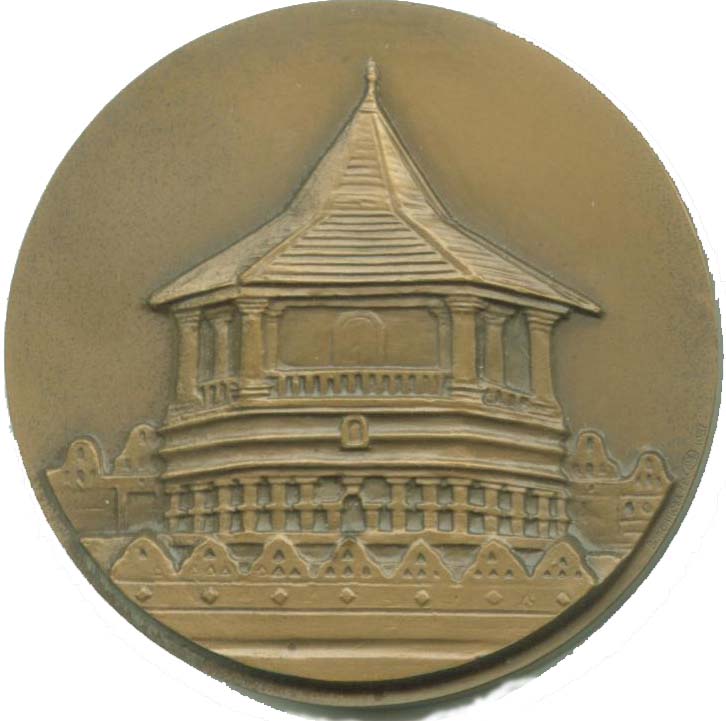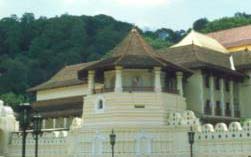| SPECIFICATIONS | |
| Alloy | Brass |
| Type | Struck |
| Diameter | 59.8 mm |
| Thickness | 6.2 mm |
| Weight | ~113 gms |
| Shape | Round |
| Edge | Plain |
| Die Axis | 0° |
| Mint | USSR |


|

| 
| ||||||||||||||||||||
From the city of Kandy on 25 August 1980, the Director General of UNESCO launched an appeal for international solidarity to protect the "Cultural Triangle" of Sri Lanka. Kandy, founded in the 14th century and given the name of SenkadagalaPura, is the southern tip of this triangle.
International Council on Monuments and Sites in it's 1986 evaluation said
 Kandy became the capital of the kingdom in 1592, during a
troubled time when many of the islanders were fleeing to the
interior, away from the coastal areas the European powers were
fighting over. Although taken several times, the city remained
one of the bastions of Sinhala independence until the British
troops entered it on 14 February 1815. From Vimala Dharma
Suriya I (1591-1604) to Sri Wickrama Rajasinghe (1798-1815), it
was the last seat of royal power. It remains the religious
capital of Buddhism and a sacred city for millions of believers.
Enshrined in the Dalada Maligawa is the relic of the tooth of
Buddha which has long been greatly venerated. The ceremonial
high point each year is the splendid ritual of the great
processions on the feast of Esala Perahera.
Kandy became the capital of the kingdom in 1592, during a
troubled time when many of the islanders were fleeing to the
interior, away from the coastal areas the European powers were
fighting over. Although taken several times, the city remained
one of the bastions of Sinhala independence until the British
troops entered it on 14 February 1815. From Vimala Dharma
Suriya I (1591-1604) to Sri Wickrama Rajasinghe (1798-1815), it
was the last seat of royal power. It remains the religious
capital of Buddhism and a sacred city for millions of believers.
Enshrined in the Dalada Maligawa is the relic of the tooth of
Buddha which has long been greatly venerated. The ceremonial
high point each year is the splendid ritual of the great
processions on the feast of Esala Perahera.
Kandy does not possess the monumental wealth of the first two capitals of the island, Anuradhapura and Polonnaruva (included in 1982 on the World Heritage List). But, built in a small wooded valley deep in the hills around an artificial lake created by Sri Wickrama Rajasinghe between 1803 and 1807, the city has much charm. The monumental zone includes, on the northern shores of the lake, the remains of the Royal Palace with the great Audience Hall, the Temple of the Tooth, the Palace of Sri Wickrama, the Queen's apartments and bathing house, the Palle Wahala, the Ran Ayuda Maduwa. Three other monumental groups (Dewala, Malwatte Vihara and Asgiriya Vihara) are the final elements of this important complex.
Due to recent modifications the Royal Palace and the Temple of the Tooth date from the reign of Keerti Sri Rajasimha (1747 - 1782). A first temple was built in 1603, destroyed by the Portuguese in 1637, and rebuilt in 1697. As a reference to the great architecture of Anuradhapura, the first historic capital, the present grander edifice was built upon a granite substructure. In addition to granite a wide variety of materials were used for this extraordinarily rich building: limestone, marble, sculpted wood, terra cotta, metal and ivory. The painted decorations vie with the sculpted decor, and include purely decorative motifs as well as different series of figures (dancers, acrobats, animals) on the beams and ceilings.
ICOMOS recommends the inclusion of the proposed cultural property, for which the Ministry of Cultural Affairs of Sri Lanka, in a letter dated 2 April 1988, described the perimeter and the conditions of protection, on the basis of criteria IV and VI.
Criterion IV. The monumental ensemble of Kandy, rebuilt under the reign of Keerti Sri Rajasimha, is an outstanding example of a type of construction in which the Royal Palace and the Temple of the Tooth of Buddha are juxtaposed. Since the 4th century it has been customary to do this. In the descriptive account left by the Chinese traveler Hiuen Tsiang in 629, the Temple of the Tooth of Anuradhapura was in close proximity to the palace. The same was true for the temples built in every place where the relic, a true palladium of the Sinhalese monarchy, was carried each time the capital was changed.
Criterion VI. The Temple of the Tooth, the palatial complex and the sacred city of Kandy are directly and tangibly associated with the history of the spread of Buddhism, one of humanity's great religions. Built to house the relic of the tooth of Buddha, which had come from Kalinga (Orissa State, India) to Sri Lanka during the reign of Sri Meghavanna (310-328), when it was transferred a final time, the Temple of Kandy bears witness to an ever flourishing cult. For 4 beautiful interactive spherical panoramic views of Kandy look at images
The medal which is one of a set of six were minted in 1987 and donated by USSR, to Central Cultural Fund (CCF) probably as a fund raiser.
The Medal was scanned at 300 dpi and displayed at 100 dpi. It was purchased in 2005 March from CCF office in Kandy.